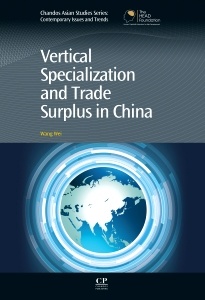Description
Vertical Specialization and Trade Surplus in China
Chandos Asian Studies Series
Author: Wang Wei
Language: English
Subjects for Vertical Specialization and Trade Surplus in China:
204 p. · 15.5x23.2 cm · Hardback
Out of Print
Description
/li>Contents
/li>Biography
/li>Comment
/li>
List of figures and tables
List of abbreviations
Acknowledgements
About the author
Chapter 1: Introduction: Trade surplus in China – vertical specialization and related issues
Abstract:
The starting point: China’s vertical specialization trade
Trade surpluses are as much a source of conflict as strength
Analyzing the impact of vertical specialization on China’s trade surplus
Chapter 2: Vertical specialization trade patterns and China’s trade surplus
Abstract:
China’s trade: more and more centered on trade surplus
Vertical divisions of labor driving China trade
China’s trade is still dependent on western markets for final goods exports
Three optimized trade development zones: regional foreign trade disparity in China
Chapter 3: An analysis of the role of vertical specialization in the development of China’s trade surplus: evidence from 2000–2007
Abstract:
Introduction
Import and export of commodities: structure and trade pattern transition in China
What role for vertical specialization trade in China’s trade surplus?
Conclusion
Chapter 4: Vertical specialization, FDI and China’s import–export imbalance
Abstract:
Introduction
China’s acceleration into vertical specialization due to FDI
Empirical evidence of the relationship between FDI and international trade in China based on VS
Conclusion
Chapter 5: FDI and the processing trade in China: based on vertical specialization
Abstract:
Introduction
Processing trade: the form of China’s strong involvement in vertical specialization
Empirical evidence: the relationship between FDI and the processing trade
Conclusion
Notes
Chapter 6: An empirical analysis of the relation between imports and exports of China’s foreign-invested enterprises based on vertical specialization
Abstract:
Introduction
Empirical evidence: the relationship between imports and exports of foreign invested enterprises (FIEs) in China
Conclusion
Chapter 7: An empirical study of the relationship between the US FDI inflows and China–US bilateral trade imbalances: based on vertical specialization
Abstract:
Introduction
Unique features of China-US trade due to vertical specialization considerations
Empirical test
Conclusion
Chapter 8: A cointegration analysis of the linkage between US exports to China and US imports from China based on vertical specialization
Abstract:
Introduction
Empirical evidence: the relationship between US Exports to China and US Imports from China
The Error-Correction model for the long-run relationship between {LNEX_SA} and {LNIM_SA}
Conclusion
Chapter 9: FDI, processing trade and China–Japan bilateral trade imbalance
Abstract:
Introduction
Evolution of the China–Japan trade pattern
Japanese direct investments in China, Chinese processing trade and China–Japan bilateral trade: empirical evidence
Conclusion
Chapter 10: An empirical analysis on transformation of China’s foreign trade development mode: based on vertical specialization
Abstract:
Introduction
Conceptual framework of vertical specialization and mode transformation of foreign trade development in China
The impact of vertical specialization on mode transformation of foreign Trade development in China: empirical evidence
Conclusion
Chapter 11: Closing remarks: rebalancing the Chinese trade
Abstract:
Appendix
References
Index
- Measures VS across China including the developed provinces based on the newest input-output table
- Presents the main provinces and products closely related to VS
- Gives evidence on global VS trade patterns from China’s national data




